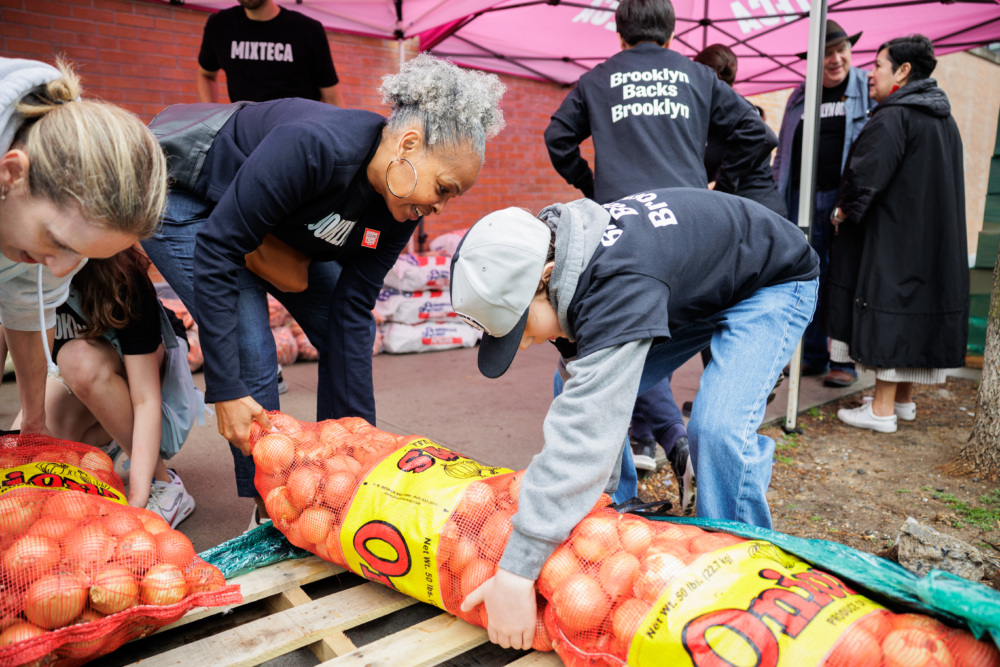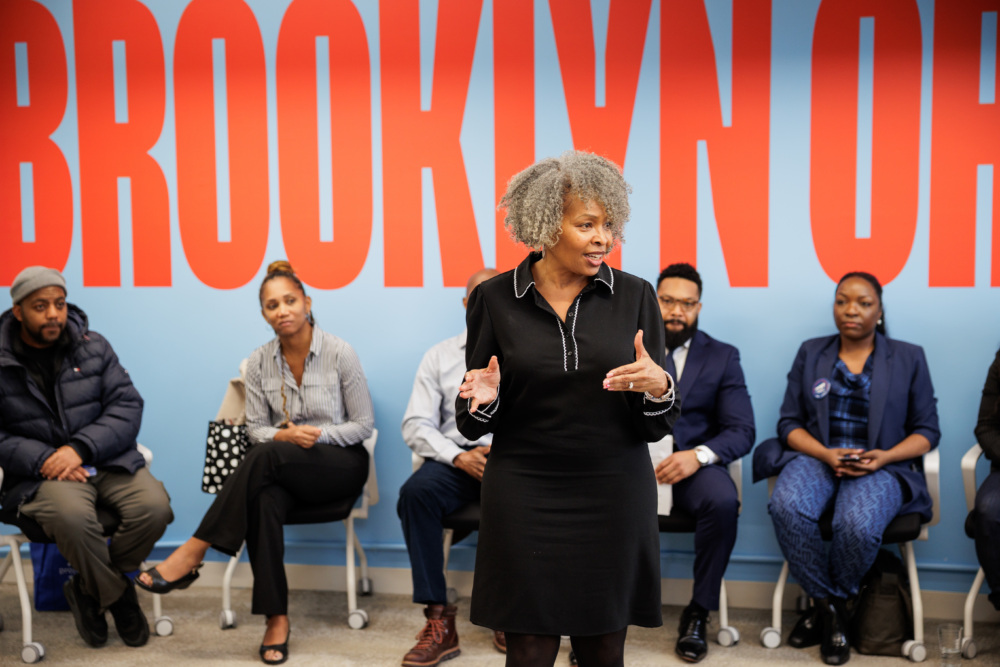Brooklyn Paper: Hundreds Lend A Hand Across Borough For Brooklyn Org Volunteer Day

When Aria Florant, cofounder of Liberation Ventures, told her audience at the Grantmakers for Effective Organizations’ 2022 national conference that “[the project of] reparations needs to shock the system, needs to disrupt White supremacist narratives, close the racial wealth gap, and build a culture of repair,” a question that arose for us was: How can we bring the insight and promise of the reparations movement to philanthropy, and how do we best use philanthropy to support the work of reparations?1
“The American dream,” a term coined by writer and historian James Truslow Adams in 1931, promises that all Americans can obtain the wealth and societal advantages that will allow us to thrive “regardless of the fortuitous circumstances of birth or position.”2 In the decades since, the American dream as we know it has become a “rags to riches” promise of wealth and fame, if we choose to work hard enough, and the ability to earn more and have more than the generation who came before.3 It is a dream that has no grounding in our economic reality of growing inequality,4 and it is a promise that has never extended to Black Americans and Indigenous peoples, who have systemically been denied opportunities through the United States government’s own decrees and legislation.5 America’s economy—and its White residents specifically—have benefited from and been fueled by the institution of slavery and the stealing of Native land.
Philanthropies like ours—the Robert Sterling Clark Foundation and the Brooklyn Community Foundation— that are funding work to address social, economic, and racial injustice must reckon with this contradiction and support the work of reparations.
We believe that we are working in a liminal time and space. We have made some progress toward leaving behind the charity mindset and exclusively White-held decision-making power, and have begun listening to new sources of wisdom beyond the traditional White male philanthropist. But we are not yet living in a liberated world where capital is distributed evenly and the leaders of our society reflect this country’s full spectrum of humanity.
We start with the conviction that philanthropy should not be about individual outcomes or individual generosity but rather about our collective future and our collective responsibility to one another. We believe that we must fundamentally change how philanthropy both conceptualizes and implements its work, and we are cognizant that it will take time, strategic thinking, and perseverance to make these changes. We have to get this right.
We are contemplating what for us is the task for this moment: How can those of us who sit at foundations but are not experts in reparations shift our behaviors and practices? How can we give Black leaders, Indigenous leaders, and other leaders of color the support they need while helping to create the conditions required to achieve collective liberation? Many of our foundations have only just begun the full work of reparations: reckoning, acknowledgment, accountability, and redress.
So, is there a way at present to authentically and helpfully integrate a reparative framework that helps to move the field?
From where we are located—at foundations that are committed to equity but sit squarely in the capital markets, have traditional board and staff structures, and whose missions center racial justice but not reparations and liberation—we believe there are some steps that we can take and some practices that we can integrate, starting now. This is new territory for us, and we welcome friends, colleagues, and allies to help shape these practices, add others, and spread them.
With these broad recommendations in mind, we turn the mirror onto our organizations and ask these questions of ourselves, acknowledging that we are not engaged in true reparations work.
The Movement for Black Lives’ Reparations Now Toolkit tells us:
[R]eparations include five key components: Cessation/Assurance of Non-Repetition, Restitution and Repatriation, Compensation, Satisfaction, and Rehabilitation. Reparations are a concept rooted in international law that involves specific forms of repair to specific individuals, groups of people, or nations for specific harms they have experienced in violation of their human rights. Therefore, reparations cannot be achieved simply through “acknowledgment or an apology” or “investment in underprivileged communities.”11
So, then, what can we do to ready our organizations and communities to embrace the full work of reparations?
First, as our colleague Edgar Villanueva’s reparative philanthropy framework adjures: Acknowledge “the history of your institution and how colonization, slavery, and other forms of oppression facilitated the accumulation of the wealth that you protect, grow, and distribute.”12
At the beginning of every meeting with potential and current grantee partners, the Robert Sterling Clark Foundation shares the foundation story of its wealth.13 The hope is that in doing so, we illustrate how it was gathered and the questionable ethics therein. Further, the hope is that it makes clear that the staff of the foundation have no hold on or claim to this money.
The Brooklyn Community Foundation, on its end, was established in 2009 with over $70 million in assets from a private foundation that had been created by the Independence Community Bank as part of its IPO in 1998.14 However, the bank’s history in Brooklyn dates back to the 1850s, encompassing eras of intense wealth building for White residents and explicit exclusion of Black residents from the banking system and the paths it provided to generational wealth building like home ownership. The vast racial wealth gap in our communities today was fostered through the racist redlining practices of banks, including by the foundation’s founders.
Second: Name and redistribute “the power you have acquired by your proximity to wealth.” Transform “competition, compartmentalization, and bureaucracy in [your] organizational culture and structures facilitated by white dominant culture.”15
The Brooklyn Community Foundation adopted a racial justice lens in 2014. This followed a broadscale community engagement process, through which it heard loud and clear that its work was toothless unless it acknowledged systemic racism and committed to addressing the root causes. It was a shift that lost the foundation a few board members and donors, but it also created a new source of momentum and purpose. Then, in 2020, in the wake of the murder of George Floyd and the national outrage that followed, the foundation deepened its commitments to racial justice grantmaking by adopting participatory grantmaking approaches across all of its unrestricted funding initiatives, to fully share decision-making power with communities of color. The profound national moment fortified its understanding that the work of truly redistributing power for racial justice requires it to be “all-in.”
The Robert Sterling Clark Foundation has, since 2018, adopted and advocated for the principles of trust-based philanthropy and named the power held by funders, so that it defuses that power, cuts bureaucracy, and generates authentic working relationships built of trust and respect.16 In January 2020, the foundation colaunched (with the Whitman Institute and the Headwaters Foundation) the Trust-Based Philanthropy Project, a five-year, peer-to-peer funder initiative to help transform the sector. This involves a lot more than just providing general operating support; it is a holistic approach that has altered the foundation’s practices,17 culture,18 structures,19 and leadership.20 It centers equity, humility, and transparency; rebalances the funder–grantee power dynamic; and builds relationships that honor how it treats others on the path to winning on the issues as much as the act of winning itself.
Third: Engage “in the Seven Steps to Healing [Grieve, Apologize, Listen, Relate, Represent, Invest, Repair21]in order to build authentic relationships that can facilitate repair for communities that continue to be burdened by the legacy of colonization, slavery, and other forms of oppression and contribute to collective healing for everyone.”22
Both of our foundations are already deeply committed to the step of listening. The Brooklyn Community Foundation firmly believes that the people who are closest to the challenges are closest to the solutions. They feel the pain of our broken systems, and they have the wisdom to fix them. Starting in 2022, following two years of pandemic-enforced isolation, the foundation launched a new approach to community engagement with its annual Listening Tour series.23 Brooklyn is home to dozens of neighborhoods and micro- neighborhoods, and it is the foundation’s duty to get out and hear from them rather than waiting for them to come to it—or relying on intermediaries. In 2022, the foundation hosted conversations in 10 neighborhoods with nearly 200 residents. In 2023, it will visit 10 new neighborhoods, followed by an additional 10 in 2024. It will continue this listening cycle every three years, to make sure its understanding of the communities is as dynamic as the communities themselves, that it’s always building new relationships with residents and organizations, and that it’s accountable for the commitments it has made to each.
Like the Brooklyn Community Foundation, the Robert Sterling Clark Foundation has instituted new ways of convening grantees that center listening and learning with and from them. But it has a long way to go, and the path forward runs counter to the way that organized philanthropy has been doing business. Its systems are not set up to take on those seven steps to healing noted above, and it is looking to others for guidance on how to move, even as it acknowledges its responsibility to do so.
This is daunting work, for sure. It disrupts how philanthropy has traditionally done business and invites a reexamination of everything—our jobs, our power structures, our endowments. And these times demand that we do this internal examination without taking time, dollars, or energy away from the work we are funding. We need to work on ourselves, but we cannot stop working on the world. It is hard and confusing work, and there are no great examples to follow. Fortunately, it is also thrilling and inspiring work, and it gets us closer to a world in which we can all thrive.
Notes

